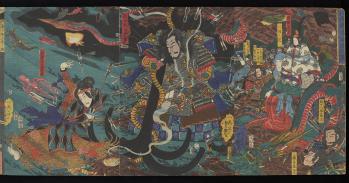
Food history breaks down our understanding of national borders: Barak Kushner is examining how interactions between China and Japan have shaped modern Japanese cuisine.
Food history breaks down our understanding of national borders: Barak Kushner is examining how interactions between China and Japan have shaped modern Japanese cuisine.
The real story is the cultural development, the travels, the people and the events that formed how the Chinese and Japanese ate.
Often regarded as the emperor of modern cuisine in Japan, ramen (a savoury noodle soup that takes half a day to prepare) accounts for approximately 26% of all meals eaten outside the home in Japan. Ramen restaurants dominate the urban and rural landscape. There are ramen museums, as well as ramen-dedicated comic books, rock songs, TV contests, magazines, websites and even a scholarly journal.
Instant ramen, invented in 1958 as an antidote to post-war malnutrition, is even more popular and has made ramen an international food. Currently, the world consumes over 65.2 billion packages of instant ramen a year, with over 200 different varieties to enjoy.
But ramen is not a true Japanese national dish as many would believe. To understand ramen’s cultural and economic influence in the international scene, Dr Barak Kushner, from the Department of East Asian Studies, is charting the history and shifts in food culture across East Asia. The real story is the cultural development, the travels, the people and the events that formed how the Chinese and Japanese ate.
Noodle soup: a force of history
Dr Kushner’s analysis of Chinese and Japanese menus, Imperial diaries, travelogues, government archives, military reports, science magazines and ancient food treatises suggests that what we insist belongs to ‘Chinese cuisine’ or ‘Japanese food culture’ is flawed.
Historically, the Japanese ate little meat, little oil and very little spice, but in the early 20th century the national cuisine began to change in response to cultural and political drivers, ultimately re-shaping national identity through food culture. At this time, labour unions were growing in strength and were attempting to secure better wages and a reasonable workday; caloric and inexpensive dining had become a necessary ingredient for urban expansion.
After much iteration, ramen entered the Japanese market as a cheap meal for itinerant peddlers, wage labourers and poor students. Chinese students living in Japan were one of the largest foreign groups, greatly influencing lower- and middle-class restaurant offerings in urban areas. After the Sino-Japanese War in 1895, they came in increasing numbers to study how Japan modernised so quickly. Students as well as labourers flocked to the new communities and their growing economic surge created new food demands.
This symphony of new tastes, combined with the need to eat out, and influenced by Japan’s expanding empire, spurred the opening of new restaurants that offered a cuisine not formerly found in Japan. For example, in 1911, the owner of the Takeya Cafeteria in Sapporo, in the extreme north, hired a Chinese cook who created a stew-like dish with meat, broth and springy noodles, calling it ‘Shina soba’, or Chinese noodles.
Other restaurants around the country began to offer similar fare but it was not until the post-war era that the dish became known in Japanese as ramen. Much later with the export of instant ramen the dish took on its new nationality.
Political revolutions are menu revolutions
Believing ramen to be a timeless Japanese dish is similar to the misconception that fish and chips is a long-time traditional British meal. In both cases, the dishes actually evolved from early 20th-century social and political changes that deeply altered the landscape of their respective national cuisines and, until recently, were not distinctive features of either culture. Dr Kushner’s research suggests that, contrary to that popular saying, we are probably not what we eat.
For more information, please contact the author Dr Barak Kushner: (bk284@cam.ac.uk; www.barakkushner.net) at the Department of East Asian Studies, or see his forthcoming book The Noodle that Changed the World (Hurst Publishers). The author thanks the Freeman Foundation in the USA and the Japan Foundation Endowment Committee in Britain for their support.
This work is licensed under a Creative Commons Licence. If you use this content on your site please link back to this page.





